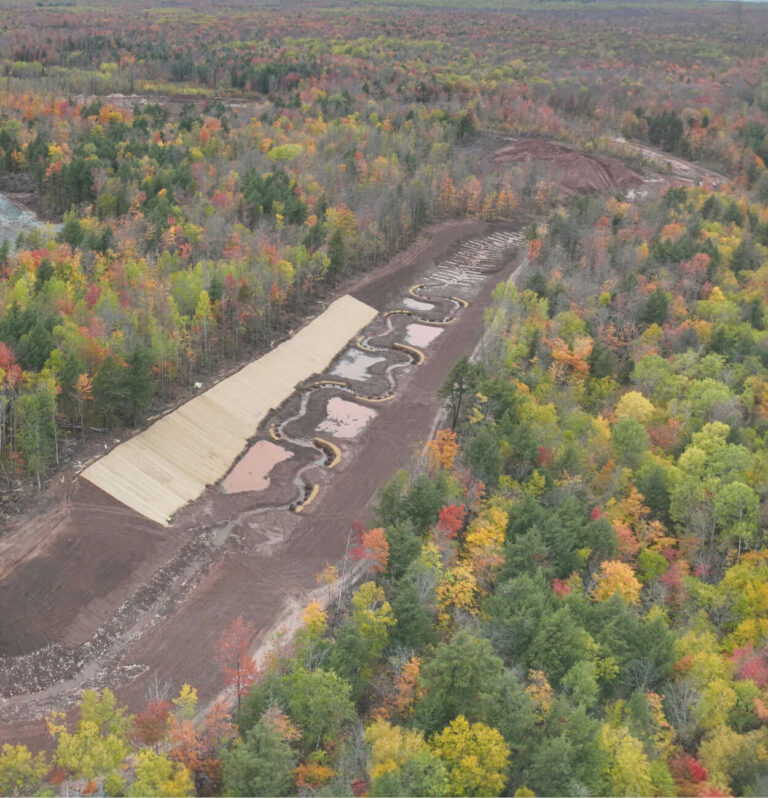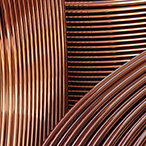Fully Permitted, Government-Backed: Highland Copper Targeting Construction Decision by 2026

Highland Copper: Fully permitted US copper developer targeting 2026 construction decision. Strong govt support, copper price leverage, experienced mgmt team.
- Highland Copper operates one of the most advanced copper development projects in the US with full permits in place for the Copperwood project in Michigan's Upper Peninsula
- At $4/lb copper, the project shows 170 million NPV with 18% IRR; at $5/lb copper, NPV jumps to 510 million, demonstrating significant price sensitivity
- The company has secured 22 formal resolutions of support from local authorities, state backing including a proposed $50 million grant, and federal legislative endorsement
- CEO Barry O'Shea brings mining finance expertise, with Orion Mine Finance holding a 28% equity stake providing both capital and potential project financing
- Targeting construction decision by first half 2026 with 11-year initial mine life producing 30,000 tons of copper annually at 400 million capex
Highland Copper Company represents a rising investment opportunity in the critical minerals sector, with CEO Barry O'Shea positioning the company as "one of the most advanced copper developers in the US" at a time when domestic copper production has become a national priority. The company's Copperwood project in Michigan's Upper Peninsula stands out as a fully permitted, construction-ready copper mine that could begin production within three years, addressing the growing supply-demand imbalance in this strategic metal.
Executive Leadership & Strategic Vision
Barry O'Shea brings a proven track record in mining finance and development, having spent 15 years in the industry with particular expertise in taking projects from development through production. His most recent experience as CFO of Fiore Gold demonstrated his ability to execute successful mining cycles, where the company acquired Nevada gold assets from bankruptcy, brought them back into production, and ultimately sold them to Calibre Mining in a value-creating transaction.
This experience directly translates to Highland Copper's current situation, where the focus is on responsible project development and capital allocation. O'Shea emphasizes the importance of execution in mining development:
"Those lessons are mainly around execution. How do you actually build a project responsibly and make a responsible construction decision and add value through that cycle."
The Copperwood Project: Technical & Economic Overview
The Copperwood project represents a substantial copper resource with 3.7 billion pounds of defined copper across all categories. The feasibility study, completed by G Mining, outlines an 11-year initial mine life producing 30,000 tons of copper annually with a capital expenditure requirement of approximately $400 million.
The project's economics demonstrate strong sensitivity to copper prices. At the $4 per pound copper price used in the feasibility study, the project delivers a net present value of $170 million with an 18% internal rate of return. However, O'Shea highlights the significant leverage to higher copper prices:
"If you increase copper price from $4 to $5, it's a 25% increase in copper price, it's actually a 300% net increase in net asset value. So from $170 million to about $510 million."
This price sensitivity is particularly relevant given copper's recent price appreciation and the long-term demand drivers supporting the metal. The project's grade of 1.5% copper from 54 million tons of measured & indicated resources provides a solid foundation, with an additional 79 million tons in the inferred category suggesting potential for mine life extension.
Permitting Advantage & Regulatory Environment
One of Highland Copper's most significant competitive advantages is its fully permitted status. Unlike many mining projects that face years of regulatory approval processes, Copperwood holds all seven required state permits from Michigan and operates on private land, avoiding the lengthy federal NEPA (National Environmental Policy Act) process.
"What distinguishes our project is that we are fully permitted. We operate on private land in Michigan. So we have the good fortune that we don't need to run through a full federal NEPA process and we've taken benefit of that. We have all permits in good standing."
The regulatory framework in Michigan reflects modern environmental standards, with mining legislation enacted in 2004 receiving unanimous approval from both state houses and support from environmental organizations. This regulatory environment requires substantial environmental mitigation - for example, the company must preserve or create wetlands at a 12-to-1 ratio for any wetlands disturbed - but provides certainty for operations.
Barry O'Shea, CEO of Highland Copper
Government Support Across All Levels
Highland Copper has secured unprecedented levels of government support, from local townships through federal legislators. The company has obtained 22 formal resolutions of support from counties and townships, including those where the project is located. At the state level, the Michigan Economic Development Corporation has proposed a $50 million grant, which has passed through the Michigan Strategic Fund and received approval from the House Appropriations Committee.
Federal support includes endorsements from three local members of Congress and Senator Ed McBroom, who have written op-eds supporting the project's regional and national importance. O'Shea's recent meetings in Washington revealed the depth of federal interest in domestic copper production:
"I was taken aback at just how up-to-date they were, how well-versed they were in copper... both talking to members of natural resources committee as well as armed services committee, the importance both from an energy and a defense perspective."
This multilevel government support reflects the strategic importance of domestic copper production for national security, renewable energy infrastructure, and economic development in traditional industrial regions.
Strategic Partnerships & Capital Structure
Highland Copper's shareholder base reflects institutional confidence in the project, led by Orion Mine Finance with a 28% equity stake. Orion's involvement is particularly strategic, as O'Shea explains:
"Naturally they will look to see if they can take on project finance, and I think they'll be a good fit from that perspective."
This relationship provides not only equity capital but also a clear path to debt financing for construction. The company's focus on "good long-term loyal shareholders" who "understand the value of the US domestic story" has created a stable capital base that can support the multi-year development timeline required for mining projects.
White Pine North: Portfolio Expansion Strategy
Highland Copper maintains a one-third interest in the White Pine North project through a joint venture with Kinterra, a Canadian private equity firm specializing in battery metals. This strategic partnership allows Highland Copper to maintain exposure to a larger, longer-dated asset while focusing resources on Copperwood development.
White Pine North is a past producer that operated for 50 years until the mid-1990s, typically producing 40,000-45,000 tons annually at approximately 1.1% grade. The current preliminary assessment indicates a 22-year mine life, making it "arguably a multi-decade project for the future," according to O'Shea.
The two projects are complementary, located about an hour apart and sharing similar geological characteristics, though each requires distinct processing approaches. O'Shea sees eventual consolidation potential:
"Those two assets belong together at some point, whether that's us consolidating them, whether that's Kinterra, or arguably an intermediate or base metal producer looks to consolidate them."
Technical Development & Risk Mitigation
Highland Copper is currently in phase one engineering, working with DRA Global and other specialized consultants to advance the project to approximately 40% engineering completion by the first half of 2026. This level of engineering detail will provide sufficient certainty for both construction decision-making and project financing.
Key technical work includes optimizing the process flowsheet, particularly investigating ultrafine flotation technology using Jameson cells and similar innovations. The current flowsheet achieves 86% recovery with a 30% concentrate grade, but O'Shea believes improvements are possible:
"We can improve the grade concentration from that perspective... arguably in the July / August time frame. We'll look to issue some of those results."
The project benefits from extensive historical data, including geotechnical information dating back to test shafts sunk in the 1950s. DRA Global's review has found "no fatal flaws in the design as contemplated in the feasibility study," providing confidence in the technical approach.
Market Timing and Strategic Positioning
Highland Copper's development timeline aligns favorably with the critical minerals initiative and copper market dynamics. The company expects to be ready for a construction decision by the first half of 2026, with production beginning 2-3 years thereafter. This timeline positions Highland Copper to enter production as copper supply constraints intensify. O'Shea emphasizes the strategic timing:
"What the US needs now is projects that can be built and not ones that are sitting at first drill hole."
This construction-ready status differentiates Highland Copper from earlier-stage exploration companies and positions it to benefit from both private investment and potential government funding initiatives.
The Investment Thesis for Highland Copper
- Rare Fully Permitted Status: Unlike most copper developers, Highland Copper holds all required permits and operates on private land, eliminating years of regulatory risk and uncertainty
- Exceptional Copper Price Leverage: A 25% increase in copper price from $4 to $5 per pound generates a 300% increase in NPV, from $170 million to $510 million, providing significant upside potential
- Strategic Government Partnership: Proposed $50 million state grant, federal legislative support, and 22 local government resolutions create a unique public-private partnership model
- Strong Capital Structure: Orion Mine Finance's 28% equity stake provides both patient capital and clear path to project financing for construction phase
- Construction-Ready Timeline: Targeting construction decision by first half 2026 with production beginning 2-3 years later, positioning to capture copper supply shortage
- Portfolio Optionality: One-third ownership in White Pine North project provides exposure to larger, longer-life asset with potential consolidation upside
- Modern Environmental Standards: Operating under stringent 2004 Michigan mining legislation demonstrates commitment to sustainable practices while maintaining social license
- Regional Mining Infrastructure: Located in established mining district with supportive community, existing workforce, and proximity to Great Lakes transportation networks
- Critical Minerals Exposure: Positioned to benefit from U.S. government initiatives to secure domestic copper supply for defense, energy transition, and economic security
The United States faces an unprecedented challenge in securing reliable supplies of critical minerals essential for national defense, renewable energy infrastructure, and technological advancement. Copper sits at the center of this challenge, with domestic production having declined significantly over decades while demand continues to accelerate driven by electric vehicles, data centers, and grid modernization.
Highland Copper's development occurs against this backdrop of strategic mineral security becoming a bipartisan priority in Washington. The company benefits from federal executive orders, state-level initiatives, and local government support that collectively recognize copper mining as essential infrastructure rather than just another industrial activity. This shift in policy environment creates unique opportunities for domestic copper developers with shovel-ready projects.
The timing convergence is particularly compelling. Copper prices have reached levels that make previously uneconomic domestic projects viable, while government support mechanisms provide additional capital and risk mitigation. Projects like Copperwood that can reach production within 3-5 years address the immediate supply challenge, while the broader policy environment supports long-term investment in domestic mineral production capacity. CEO Barry O'Shea captured this opportunity succinctly:
"We're really ready in the next year to look to make a construction decision, build our project over the next two to three years and really help with that global supply demand imbalance."
This positions Highland Copper not just as a mining investment, but as a strategic play on America's industrial renaissance and energy security objectives.
Analyst's Notes




Subscribe to Our Channel
Stay Informed























